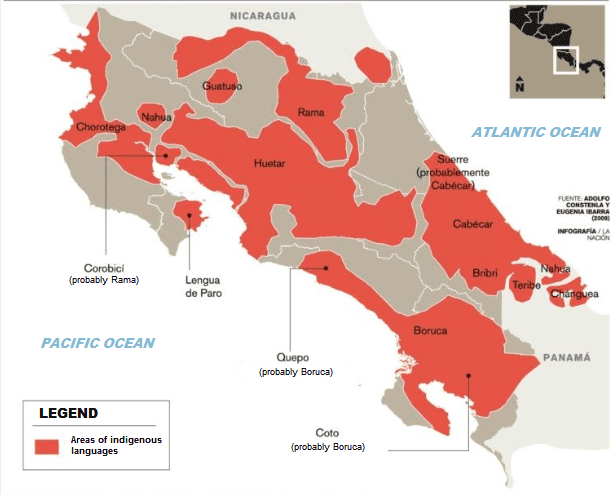 | ||
Costa Rica's official and predominant language is Spanish. The variety spoken there, Costa Rican Spanish, is a form of Central American Spanish.
Contents
Map of Costa Rica
Costa Rica is a linguistically diverse country and home to at least five living local indigenous languages spoken by the descendants of pre-Columbian peoples: Maléku, Cabécar, Bribri, Guaymí, and Buglere.
Immigration has also brought people and languages from various countries around the world. Along the Atlantic Ocean in Limón Province, inhabited primarily by Afro-Caribs, an English-based creole language called Mekatelyu or Patua is spoken to varying degrees, as is English; many older Limonenses speak English as their native language. The Quakers community, who settled in Monteverde in the early 1950s, speaks an older dialect of English, using thou instead of you. Costa Rican Sign Language is also spoken by the deaf community, and Costa Rican Spanish slang is known as "pachuco".
Traditionally, Costa Rica has had no policies in favor of multiculturalism. The greatest advance in this respect came with the amendment of Article 76 of the Constitution of Costa Rica, which now states: "Spanish is the official language of the Nation. However, the State will oversee the maintenance and cultivation of indigenous national languages."
Living indigenous languages
Currently, in Costa Rica, there are five indigenous languages that are still used by their respective populations. All of them belonging to the Chibcha language family. Those languages are:
Extinct and formerly spoken languages
Prior to the 9th century, only languages of the Chibchan family were spoken in Costa Rica. The extinct Huetar language, probably affiliated with the Chibchan family, served as the lingua franca for the interior of Costa Rica and was considered by the Spanish upon their arrival to be the "general language" of all Costa Rica.
Historically, the range of the still-living Rama language also extended south into northern Costa Rica, where the Maléku language was also spoken. Boruca, an Isthmic Chibchan language, was formerly spoken across the southern Pacific slope while Bribri and Cabécar speakers inhabited the northern Atlantic slope. An unknown language, known only as the lengua de Paro, was also spoken on the western coast of the Gulf of Nicoya.
During the 9th century, speakers of the now-extinct Oto-Manguean language Chorotega controlled most of northeast Costa Rica. Other Mesoamerican peoples penetrated Costa Rican territory. The Nahua speakers known as Nicarao, named after their cacique of the same name, lived in enclaves in Guanacaste Province as well as near the delta of the Sixaola River, speaking a dialect closer to nuclear Nahuatl in Mexico than to the Pipil of El Salvador and Nicaragua.
At the beginning of the 21st century, two Costa Rican indigenous languages became extinct. Térraba, a variety of the Téribe language, was spoken in the indigenous reserve of Térraba in the southeast of Puntarenas province. Until its recent extinction, Boruca was spoken in the Boruca and Curré reserves in the southeast of Puntarenas province.
